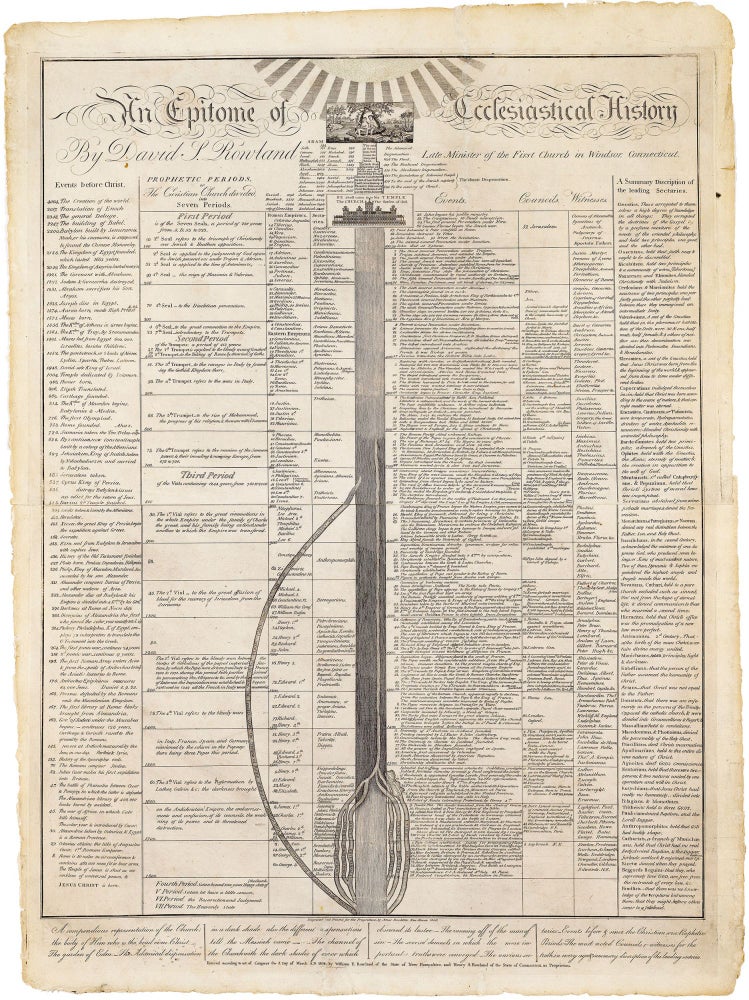An Epitome of Ecclesiastical History By David S. Rowland Late Minister of the First Church in Windsor, Connecticut.
New Hampshire: William F. Rowland and Connecticut: Henry A. Rowland, 1806. Engraving on two sheets joined, 33 5/8”h x 24 7/8”w at neat line plus margins, uncolored. A remarkable—and mammoth—broadside chronological chart employing text and images to depict six millenia of ecclesiastical and secular history. The Epitome was designed by the Rev. David Sherman Rowland (1719-1794), who began his career as a minister in Providence, Rhode Island but was “forced to flee his pulpit there because of his inflammatory exhortations on freedom and taxation.” (http://www.fcwucc.org/history) He spent the rest of his career a minister of the First (Congregational) Church in Windsor, Connecticut. He was succeeded in 1790 by his son the Rev. Henry Augustus Rowland (1764-1835), who, along with his elder brother William Frederic Rowland (1761-1843), pastor of the First (Congregational) Church in Exeter, New Hampshire, arranged for the chart’s posthumous publication. The earliest announcement appeared in the New-Hampshire Gazette for June 17, 1800 and described the chart as follows: This Epitome contains a compendious representation of the Church—the garden of Eden—the Adamical Dispensation in a dark shadow—also the different Dispensations till the Messiah came—the state of the Church, with the dark shades of error which obscured its lustre—the running off of the man of sin—the several channels in which the more important truths were conveyed—the various sectaries—events before and since the Christian Era—Prophetic periods—the most noted councils—witnesses for the truth in every age—and a summary description of the leading sectaries” (p. 4) An advert appeared soon after in the Courier of New Hampshire for July 5, 1800 (p. 4), offering subscriptions for $2 per impression, with “the work to be put in execution as soon as 500 copies are subscribed for.” It must have taken time to drum up the requisite number of orders, as the Epitome was not published until 1806. The finished product appears very much as advertised. The body is divided into eight columns, of which the central six constitute a timeline of “The Christian Church divided into Seven Periods,” the first beginning in 9 A.D. and the last concluding at some indefinite future date with “The Heavenly State”. These six columns list emperors and kings, major sects, key secular events (with the years 1600-1800 emphasizing early American history), Church Councils, and major religious figures. The left-most column provides a chronology of pre-Christian history, while that on the right gives brief descriptions of the “leading sectaries”. The central image depicts the Church as a large river flowing from Solomon’s Temple, with numerous branches splitting off, particularly during the Reformation, and the anticipation that they will reunite in the main stream of the Church in the future. As mentioned earlier, Rowland was an ardent patriot, and the broadside holds an implicit message about the linked courses of Church and American history: The final three secular events listed are the Declaration of Independence, the Federal Constitution and the French Revolution, suggesting that the new republics would prefigure a period of ecclesiastical unity and peace. Stylistically, An Epitome of Ecclesiastical History is an interesting hybrid. On the one hand, most of its chronological information is conveyed in the ancient “Eusebian” format, named after the 4th-century Romano-Christian chronicler . This format entailed a simple table with kingdoms or other thematic topics listed across the top and dates listed down the right- or left-most column. It was simple to execute and enabled the viewer to compare concurrent events across the known world; but it tended to be crowded, grueling to read, and not terribly memorable except for the most gifted. By contrast, the central stream image may have been inspired by Friedrich Strass’s 1803 Strom der Zeiten, which employed a visual metaphor of interweaving streams and rivers to treat the rise and fall of kingdoms and empires. Thus, Rowland’s work can be seen as a sort of compromise or transitional approach, reflecting a tentative attempt to move beyond the limits of the traditional Eusebian model without abandoning it altogether. Amos Doolittle The Epitome was engraved and published by the remarkable Amos Doolittle of New Haven. Doolittle (1754-1832) worked in New Haven and was probably America’s most prolific early engraver. His career spanned seven decades and yielded hundreds of portraits, views, book illustrations and maps, but he is best known for his historical prints, most famously his suite of engravings of the battles at Lexington and Concord. Art historians are often unjustly dismissive of his output; Stauffer for example stuffily pronounces that “his work, at the best, possesses little other than historical interest.” (Stauffer I:67) This is terribly unfair: while some of his early work—notably the Lexington and Concord engravings—was indeed crude, much of his later work is quite accomplished, as evidenced by the detail and clarity of this plan of New Haven. Even when the charge is merited however, the “historical interest” is extreme. Doolittle’s political and historical prints documented some of the most important events of his time, and he engraved some of the most significant maps issued in the early years of the republic. An early and scarce American chronological chart, produced by one of America’s great early engravers and offered here in stellar condition. REFERENCES: Rosenberg & Grafton, Cartographies of Time, pp. 148-9. Rumsey #9392. OCLC #49373383 et al, locating examples at the AAS, Clements, Huntington, CT Historical Society, NH Historical, NY Historical, Princeton, SMU and Yale. Not in Shaw-Shoemaker or Stauffer. CONDITION: Minor soiling, a few mended edge tears, including one extending 8” from the upper edge and another 3 ” from the lower edge, both expertly mended and all-but invisible. Still, untrimmed and in generally spectacular condition. Offered in partnership with Boston Rare Maps of Northampton, Mass.
Item #6785
Price: $6,500.00


